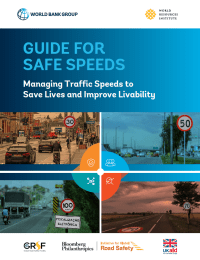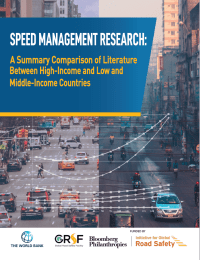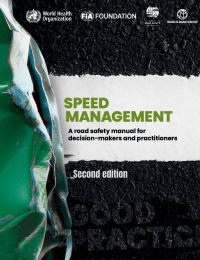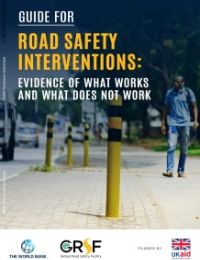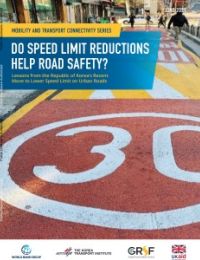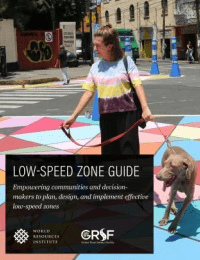Publications
1-9 of 9
-
Speed Management
Guide for Safe Speeds: Managing Traffic Speeds to Save Lives and Improve Livability
March 2024
-
Speed Management
Speed Management Research: A Summary Comparison of Literature Between High-Income and Low and Middle-Income Countries
February 2024
-
Speed Management
Speed Management: A Road Safety Manual for Decision-Makers and Practitioners (2nd ed.)
November 2023
-
Speed Management
Road Crash Trauma, Climate Change, Pollution and the Total Costs of Speed: Six Graphs That Tell the Story
July 2022
-
Speed Management
Guide for Determining Readiness for Speed Cameras and Other Automated Enforcement
July 2022
-
To briefly identify the powerful practical value of AE in saving lives and reducing injuries.
-
To identify issues and criteria to be considered before commencing automated enforcement. To identify steps to be taken to achieve readiness for automated enforcement. To identify issues to improve existing automated enforcement systems.
-
To provide a checklist to ensure adequate consideration is given to issues to assess readiness to implement an AE system or improve an existing system.
- Evaluate the effectiveness of the reduced speed limits in terms of crash reduction through a before-after study.
- Examine if the speed limit change had different effects across different crash types, user types, and crash severities.
- Evaluate the impact of speed limit change on transit speed through a before-after assessment.
- Develop appropriate and actionable recommendations for departments of transportation in developing countries.
-
-
Traffic crashes are a leading cause of death and serious injury worldwide; most notably, they are the leading cause of death and serious injury among young people aged 5–29. Higher motor vehicle speeds increase the likelihood and severity of crashes.
-
Low-speed zones have emerged as one of the most promising strategies for speed management. They can be appropriate in many different contexts and at various scales, as exemplified by case studies of successful projects around the world.
-
Low-speed zones in cities need to be well-planned, well-designed, and well-built, to maximize safety and other benefits.
-
Physical traffic-calming measures and target speeds of 30 kilometers/hour (km/h) or lower have the greatest proven safety benefits.
-
Key considerations for implementation include stakeholder engagement, site selection (including risk: pedestrian/vulnerable road user presence), enforcement, evaluation, and the adaptation of basic principles for low-speed zone design to the local context.
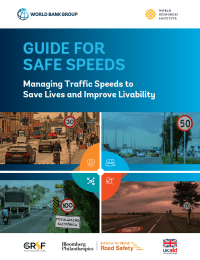
Speed is one of the main road safety risk factors and is universally recognized as the leading contributor to road fatalities and serious injuries. But there is good news: the speed problem is solvable. Interventions that are proven to be effective exist, and it is well understood where and how they should be applied.
The newly published “Guide for Safe Speeds: Managing Traffic Speeds to Save Lives and Improve Livability” outlines interventions that work and provides guidance on how to select and implement speed limits that are safe for all road users. It also explains how barriers to changing traffic speeds—which are often based on lack of knowledge or misunderstandings—can be overcome.
A primary feature of the guide is its comprehensiveness. The guide covers all types of roads—from city streets to inter-urban roads and motorways (existing or new); all types of road users—from vulnerable road users such as pedestrians and cyclists to heavy motorized traffic; all types of speed limit changes—from national general speed limits to localized changes based on risk factors; all types of challenging constraints—from lack of resources to lack of data; and all types of countries—from low-income to high-income.
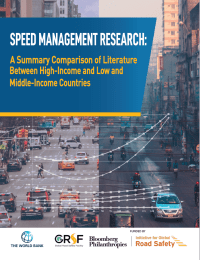
Low- and middle-income countries (LMICs) have been experiencing growth in vehicle travel and mobility but have not yet realized road safety gains experienced by high-income countries. Excessive and inappropriate speed is known to be a major cause of road crashes, injuries and deaths. Thus, speed management is considered a key initiative for improving road safety outcomes worldwide and has been applied successfully in most high-income countries.
Proven interventions do not necessarily have the same impacts in LMICs, or may not be feasible to apply, due significant differences in traffic mix, road user behavior, road design and vehicle standards.
This document summarizes current available knowledge about speed, its effects on safety, mobility and emissions, along with potential safety effectiveness of speed management initiatives in the LMIC context. Knowledge gaps for LMICs are clearly referenced for further consideration.
The knowledge summary provides a useful reference for practitioners wishing to inform themselves about traffic speeds, their selection and impacts on safety outcomes, mobility and emissions. The LMIC knowledge gaps will be useful in considering future research and data priorities.
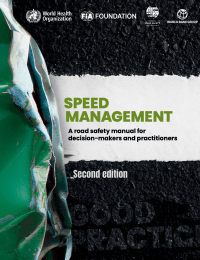
The WHO, World Bank, FIA Foundation and Global Road Safety Partnership (GRSP) produced a series of good practice manuals, following the publication of the World report on road traffic injury prevention in 2004, which provide guidance on implementation of interventions to address specific risk factors in road safety. The topics covered in the initial series of manuals were: helmets (2006), drinking and driving (2007), speed management (2008), seat-belts and child restraints (2009), data systems (2010), pedestrian safety (2013), road safety legislation (2013), powered two- and three-wheeler safety (2017) and cyclist safety (2020).
Since the series of manuals was first published, the scientific evidence base relating to various risk factors and the effectiveness of interventions have continued expanding. Contemporary research has refined our knowledge about specific risk factors, such as distracted driving, and vehicle impact speed and risk of death for pedestrians. New issues and practices have arisen, such as a tropical helmet standard and an anti-braking control standard for motorcycles. New and existing interventions have been implemented and evaluated, with increasing application in LMICs. Research attention and policy response have also increasingly been applied to emerging road safety issues including e-bikes, drugs other than alcohol, fleet safety, urban mobility, micro mobility options, air and noise pollution, public transport and technological advances.
As a result of these developments, the good practice manuals required revision so that they can continue to be key references for road safety policy implementation and research. This is particularly important, given the emphasis placed on road safety within the framework of the 2030 Agenda for Sustainable Development and because of the global impetus to reduce road deaths and injuries, resulting from the declaration of the two United Nations’ Decades of Action for Road Safety (2011–2020 and 2021– 2030). The manuals have been revised to reflect these developments as they continue to be valuable resources providing evidence-based and cost-effective solutions to save lives and reduce injuries.
The management of speed remains one of the biggest challenges facing road safety practitioners around the world and calls for a concerted, long-term, multidisciplinary response. The speed at which a vehicle travels directly influences the risk of a crash as well as the severity of injuries sustained, and the likelihood of death resulting from that crash. This manual advocates for a strong and strategic approach to creating a Safe System, with speed management at its heart. Reducing motor vehicle speeds in areas where the road user mix includes a high volume of vulnerable road users, such as pedestrians and cyclists, and on non-divided rural roads, is especially important.

Road traffic crashes result in an estimated 1.35 million deaths and 50 million injuries worldwide per year with over 90 percent of these occurring in Low-Middle Income Countries (LMICs). Aside from the obvious pain and suffering this inflicts on individuals and communities, these deaths and injuries also place a large financial burden particularly on LMICs, by slowing economic growth.
The scale of the current response to this continuing crisis does not match the size of the problem. In addition, limited road safety resources are often expended on ineffective or suboptimal interventions. While road safety knowledge has improved over recent decades, there is still a need to improve decision making when selecting and applying effective evidence-based road safety interventions. Effective interventions are those that reduce fatal and serious injuries.
The World Bank's Global Road Safety Facility (GRSF) has developed this evidence-based guide on “What Works and What Does Not Work” in road safety in response to the critical need for effective evidence-based solutions.
This guide has been prepared to help readers understand that not all road safety interventions are equally effective and that what appear to be “common-sense” approaches to selecting road safety interventions will often not be the best. Although some provide benefits, others have very limited or even negative impacts, despite being commonly—and mistakenly—recommended or accepted. The guide offers a range of recommendations with a focus on interventions in LMICs, although the information may also be of relevance to all countries. The contents will be valuable to those working on road safety at policy or practitioner levels, including World Bank technical team leaders and others who seek to establish, expand, or improve road safety programs in LMICs.
The guide sets knowledge on evidence-based interventions within a “Safe System” context, providing advice on each of the Safe System pillars (road safety management, safe roads, safe speeds, safe vehicles, safe road users, and post-crash care) while recognizing that evidence-based solutions must be drawn from across pillars to produce effective road safety outcomes. At the core of this document is a summary table with an overview of beneficial and non-beneficial interventions based on sound scientific evidence. This is followed by more detailed information including case studies and references to the evidence base to support the summary.
Many safe road interventions are recommended for adoption, including integrated public transport, roadside and central barrier systems, medians, infrastructure to support appropriate operational speed for road users, roundabouts, grade separation and interventions to reduce exposure to risk at intersections, pedestrian footpaths and crossings, separated bicycle and motorcycle facilities, and traffic signs and line marking (including audio-tactile line marking). Some of these are highly effective, with up to a 70 or 80 percent reduction in fatalities and severe injuries (for example, safety barriers and roundabouts).
Various speed-related interventions also produce significant benefits, with some able to almost eliminate death and serious injury. Examples of effective speed interventions include traffic calming (including humps and chicanes), roundabouts, raised intersections and crossings, gateway treatments, lower speed limits (including 30 km/h (20 mph) zones for pedestrians) and speed cameras.
A variety of road user-based interventions have been implemented over many years, with effective examples including extensive supervised on-road practice and/or graduated licensing systems as part of the driver-licensing system, increased age for driving license eligibility, hazard perception training and testing, public education and campaigns as part of an integrated strategy (especially communicating enforcement to increase general deterrence), enforcement, penalties, alcohol interlocks, fatigue and speed monitoring, and increased helmet wearing rates.
Key vehicle-based interventions include applying minimum vehicle safety standards and vehicle ratings (through the Global New Car Assessment Program, or “NCAP”), seat belts, periodic vehicle maintenance, daytime running lights, under-run guards on trucks, Electronic Stability Control, and other advanced vehicle technologies.
Enhanced post-crash care can also produce better road safety outcomes, including systems to improve emergency response time, better emergency care, improved first aid skills for the public, and improved hospital care.
Equally important, the report also identifies clear examples where interventions are not effective. The worst of these are interventions that increase risk. These include increasing travel speed without improving quality of safety infrastructure, most forms of post-license driver and rider education and training, and many (but not all) forms of regular school-based driver education (such as those that seek to increase car-handling skills). The increase in risk is typically because such initiatives increase the level of confidence leading to an increase in risk taking. Other interventions that have no demonstrated safety benefits are to be avoided. These include license schemes through application or payment, training programs or education within schools that aim to improve road safety knowledge (including ad hoc visits by road safety experts or enthusiasts), and education campaigns conducted in isolation.
There are effective alternative interventions for each of these as described within this document, and these should be applied instead. It is extremely important that resources are not wasted on ineffective interventions on behalf of road safety but rather that evidence-based road safety interventions are employed.
There are a variety of documents available on the issue of road safety intervention effectiveness, many of which are referenced here. However, there are some key points of differences and added value in this guide, including a synthesis of the evidence on a broad range of interventions and a contrast between effective and noneffective interventions, allowing readers to compare options. Where noneffective interventions are identified, viable effective interventions are provided thereby supporting decision making. The guide also provides direct advice to those working in LMICs, drawing on key sources of information where this is available. Importantly, concise yet robust evidence is provided across each of the Safe System pillars.
There is a need to continue building the knowledge base on effective road safety interventions, particularly in LMICs where there are a number of gaps in knowledge. The contents of this guide represent a useful, up-to-date summary of current knowledge for application.

What is the real cost of speeding on people and the environment? These 6 graphs tell the story ⌵︎
The impacts of speed on the safety of road users, on congestion, on pollution, and on total costs of road travel are broadly misunderstood: often based on wrong assumptions, with effects taken as self-evident, failure to consider multiple impacts, externalization of costs by many stakeholders, and under-estimation of impacts (especially economic costs of higher speeds). The purpose of this brief note is to provide information on these relationships relevant to fundamental road transport policies, design, and operation. Well-established evidence shows the importance of managing travel speeds for road safety, for efficiency, for improved inclusion, and for greenhouse gas (GHG) and other emissions. Thus, speed management is a strong policy lever for the breadth of issues which must be addressed for sustainable mobility.
Reduced speeds of travel represent a major, yet under-appreciated, opportunity to improve safety, climate change impacts of travel, health, inclusion, the economy, and in some circumstances, congestion. Speed management can be achieved through a range of interventions including road infrastructure and vehicle technology, as well as enforcement and promotion.
The six graphs presented in this note tell a powerful story, across the range of these benefits of speed management.
This publication is also available in:

This guide has been prepared to assist a jurisdiction to determine the level of readiness to move to automated enforcement (AE). Speed cameras enforcing speed limits are a common application of AE and there are many systemic legal and operational elements that must be in place before AE can be effective. For example, an accurate image of a speeding vehicle, in the absence of robust driver licensing and vehicle registration systems, is of little road safety value. Importantly, automated speed enforcement should be considered as one part of a comprehensive speed management approach that includes road infrastructure and roadside policing as well. The management of speed is a fundamental element of the Safe System.
Aims of this document:
Other illegal behaviours, including disobeying a red light signal, mobile or cellular phone use, incorrect lane use, and non-restraint use can also be detected using an automated enforcement approach. However, this document applies specifically to automated speed enforcement, because speed management requires significant attention worldwide and plays a critical role in reducing road traffic deaths and injuries.
Document also available in French, Portuguese, Vietnamese and Spanish.
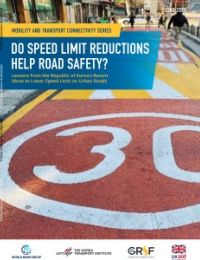
Significant research has been undertaken on how changes in speed limit—for example, the introduction of 30 kilometers per hour, or kph (20 miles per hour, or mph) speed limits—impact safety both when combined with, and without "traffic-calming" engineering treatments such as speed humps or raised platforms. However, most of the studies have been conducted in Australia or countries in Western Europe, with almost no recorded studies from Asia, Africa, the Americas, and Eastern Europe. Though it may be reasonable, a well-developed infrastructural environment such as that found in Korea would expect similar results as that of the western countries, a study originating in Asia could have a strong demonstration effect and prove very convincing for many Asian countries.
With this in mind, the main aim of this study is to present the findings from Korea’s reduced speed limits on safety performance and to support the establishment of suitable speed-management strategies based on a quantitative data-driven approach. The scope of the project was as follows:
To start, this report first provides a brief literature review on the concept of Safe System speed limits, and the effect of speed limit reductions as part of speed management in several countries, followed by a brief description of the evaluation methods for the before-after assessment. This is followed by a summary of the findings, a set of recommendations, limitations of this study, and finally, a capsule of future research that could be undertaken to either extend or follow up on the study.
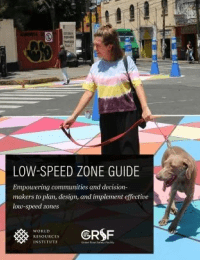
Every year approximately 1.35 million people lose their lives due to road traffic crashes. In many road crashes, speed plays a key role. As a result, managing speed has taken on great importance in cities around the world.
An effective method for reducing speed and improving road safety, especially in high-risk areas, has been to establish low-speed zones. This Low-Speed Zone Guide presents strategies for planning, designing, building, and evaluating low-speed zones. The guide intends to equip communities and decision-makers with the tools to implement low-speed zones that will suit their specific context.
Highlights:

Based on 2018 findings of the World Health Organization (WHO), the number of deaths due to road crashes is 1.35 million deaths per year. While this number is quite high and increasing every year, the rate of road crash deaths per 100,000 of population has remained constant, at around 18 deaths, over the years. This rate of deaths is however not distributed proportionately amongst the different regions and countries. The high-income countries have recorded lowest average rate at 8.3 per 100,000. In contrast to this number, low-income countries have the highest annual road traffic fatality rates averaging at 27.5 deaths per 100,000– more than three times the average for high-income countries.
ROAD CRASH AND IMPACT
Most of the deaths and injuries from road crashes are of the working age population, which negatively impacts both the economy and the demography of the region. Road traffic injuries are currently the 8th leading cause for death for all age groups, and further compounding the demographic impact is the fact that road crashes are the leading cause of death for children and young adults, between the ages of 5 and 29 years.
Road traffic crashes have a high economic impact, costing 3 percent of a country’s GDP on average. They also cause a significant impact on the individuals as well as their families. Injuries arising due to road crashes can lead to trauma for the individual and loss in productivity. Along with costs of treatment, economic challenges may further be increased due to temporary or permanent loss of income as well. Along with the victim, road crashes take an emotional toll on the immediate family members and caregivers during the treatment process or any deaths and add to the economic burden as they may need to take time off work or school to care for the injured.
The distribution of road users varies within different regions and income groups of countries. This impacts the variations in death rates amongst the users. The low- and middle-income countries have a significantly high proportion of pedestrians, cyclists and two- or three-wheeler motorized vehicles. Overall, the global road traffic deaths for pedestrians and cyclists is at 26% and another 28% for two- and three-wheeler motorcyclists, totaling nearly 54% of vulnerable road users. This proportion varies in comparison between the economic group of countries, with a high percentage of road crash victims being car occupants.
Globally, a significant percentage of road crash victims being car occupants is also an indicator of insufficient infrastructure for controlling traffic speeds and volumes. Furthermore, when people use private cars more for their daily activities, it results in a higher level of total vehicle-kilometers traveled (VKT). Choice of using personal vehicle over using non-motorized transport or public mass transport may be attributed to the car-centric planning and design of road infrastructure. Many countries lack adequate protected infrastructure for pedestrians and cyclists. This discourages users to walk or bicycle to their destinations.
Mode-choice plays a critical role in road safety. Public mass transit systems not only provide faster and safer transportation mode choices, they also help reduce dependency on privately owned vehicles on the road. Public mass transit services typically follow designated routes as well, thereby minimizing interferences between different types of road users. While many countries still have to develop mass transit infrastructure such as metro rails, public bus system is quite prevalent, with bus rapid transit (BRT) and bus only lane infrastructures being developed. Absence of proper first and last mile connectivity to the transit stations poses security threats for road users and discourages them from using public transport.
SAFE SYSTEM APPROACH
The Safe System approach derives from the Swedish Vision Zero and Dutch Sustainable Safety strategies that have a long-term goal for a road traffic system to be eventually free from fatalities and serious injuries. It represents a shift away from traditional approach of preventing collisions to a more forgiving approach of preventing fatalities and mitigating serious injuries in road crashes. The traditional approach emphasizes the responsibility of road users to avoid crashes rather than the responsibility of system designers to provide a safe mobility system.
The Safe System approach takes into account that humans are vulnerable and fallible, and errors are to be expected. It aims at ensuring these mistakes do not lead to a crash, and if a crash does occur, it is sufficiently controlled to not cause a death or a life-changing injury. Thereby with a “zero-harm goal”, it places a strong emphasis on road builder/operator and vehicle manufacturer accountability for road safety performance.
The Safe System approach emphasizes shared responsibility. Government agencies at different levels and a range of multisectoral agencies and stakeholders – including policy makers, road engineers, planners, vehicle manufacturers, enforcement officers, emergency medical agencies, road safety educators etc. – are accountable for the system’s safety and all road users – drivers, cyclists, and pedestrians are responsible for complying with the system rules.

